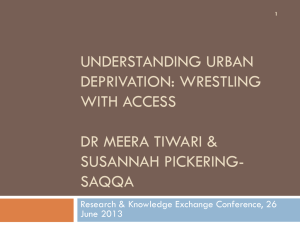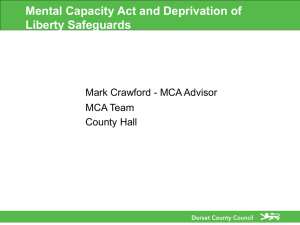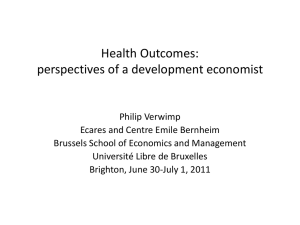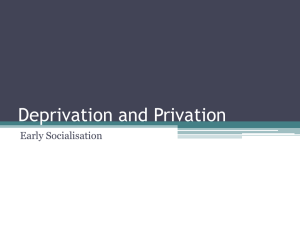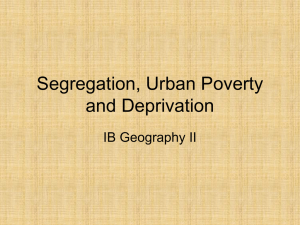Decentralization and Equity for Child Rights in
advertisement
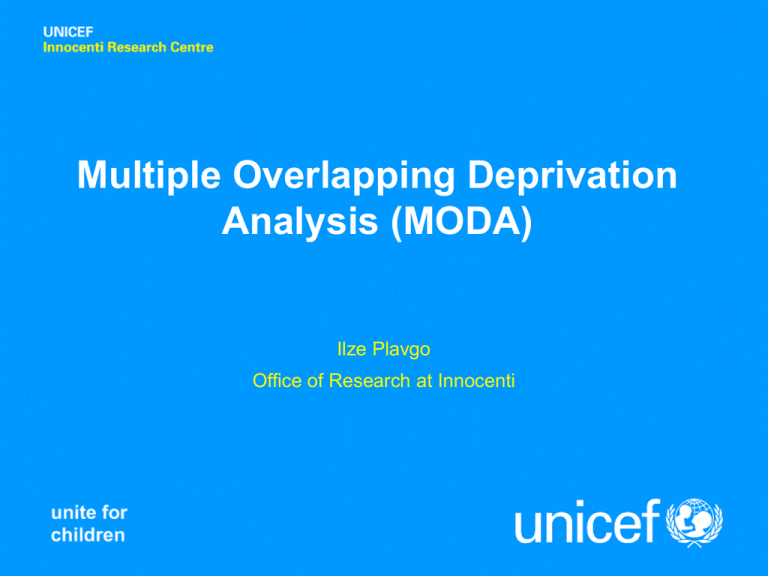
Multiple Overlapping Deprivation Analysis (MODA) Ilze Plavgo Office of Research at Innocenti What is MODA? A child-centered, multidimensional approach to measuring child poverty •Children’s needs are Child multidimensional and deprivation profiles; Supports age specific Childcentered; with the child as unit of analysis Life-cycle approach; equity focus Builds on existing initiatives to measure child poverty and deprivation: Flexible methodology; •Sector by sector analyses selecting context-specific indicators, dimensions, profiling variables etc. •UNICEF’s Global Study •Alkire and Foster methodology (also used for OPHI’s Multidimensional Combines Poverty Index, Bhutan happiness deprivation and monetary poverty index etc.) analysis; for children •Material Deprivation, Social Exclusion (Europe) capturing agespecific needs MODA Deprivation overlaps; using an integrative approach between dimensions 2 From sector approach to child centered approach Single deprivation analysis Multiple deprivation analysis 3 ‘Life-cycle’ approach • • Children’s needs are not homogenous across childhood Life-cycle approach allows to select age-specific indicators and analyse the different groups of children separately depending on their age to reflect children’s different needs in the periods of infancy, childhood, and adolescence 4 Life-cycle stages and dimensions in CC-MODA 5 MODA is flexible, not an ‘index’: “How many children suffer a deprivation?” “How many experience multiple deprivations?” versus “x% of children are multidimensionally poor.” Côte d’Ivoire 2012: children aged 5-17 years Congo DR 2010: children aged 5-17 years But.. what are these specific deprivations? Are there some that occur in isolation?.. 6 MODA supports integrative approach showing where cross-sector cooperation and linkages can be beneficial Deprivation overlap for each dimension in Ethiopia (2011) among children aged below five, by region 7 Integrated approach Which deprivations do the children suffer from simultaneously? How many and who are these children? Which sectors need a multi-sectoral, integrative approach? Are there regional differences? Overlap of nutrition, health, and water deprivations in Ethiopia (2011) among children aged below five, by region 8 MODA Supports Equity Agenda • Assists in the identification of particularly vulnerable groups • Allows to concentrate on highly deprived groups in the society and to create profiles which assist in determining their geographical and social position Deprived in Nutrition .228 - .297 .297 - .389 .389 - .45 .45 - .507 9 MODA allows integration of monetary poverty and deprivation analysis (MALI MICS & ELIM 2009-10) Overlap between monetary poverty (food/non-food line) and deprivation (K=3), <5 years 10 MODA application CC-MODA • Internationally comparable: Uses standardized definitions for age-groups, dimensions, indicators, thresholds, profiling variables; data: MICS and DHS • Using the Convention on the Rights of the Child (CRC) as guiding principles • Process: Analysis prepared by OoR • Results available in an interactive web-portal (www.unicef-irc.org/MODA/). Currently 31 cases uploaded. Results can all be exported as a pdf or Excel. • 55 countries to be completed by June 2014 N-MODA • Country-specific analysis; Done in collaboration with UNICEF COs and their national counterparts • Uses country-specific indicators, dimensions, thresholds, age-groups, data etc. • Various Objectives: child poverty study; SitAn; to help institutionalize child poverty measurement into government policies and monitoring systems; etc • SAME methodology; different decisions; different (additional) elements of alnalysis 11 Framework of the MODA methodology 12 Step-by-step Guidelines to MODA Getting started Concepts, definitions, data choice • • • • Step 1: Choose concept(s) of child well-being/poverty to be analyzed Step 2: Define deprivation and specify its dimensions, based on the chosen definition Optional – Define any other concepts of poverty (e.g. monetary poverty) Step 3: Select the dataset(s) and choose the unit of analysis Preparation for the deprivation analysis Choice of dimensions, indicators, thresholds, and age groups • • • • • • • • • Step 4: For each dimension, select indicator(s) and define the reference population Step 5: Specify indicator threshold(s) and construct the indicator(s) Step 6: Decide upon the life-cycle stages and choose age group(s) for the multidimensional deprivation analysis Step 7: Decide whether to impute values on other members of the same household Step 8: Perform a correlation test and select the final indicators Step 9: Decide how to weight indicators and how to aggregate them into dimensions Optional – Perform a scalability test and select the final dimensions Step 10: Decide how to weight dimensions Step 11: Decide upon the identification method of the multidimensionally 13 deprived children Single deprivation analysis Step-by-step Guidelines to MODA Analysis by indicator and by dimension • • • Step 12: Estimate a child deprivation headcount ratio for each indicator and dimension Step 13: Select profiling variables and construct a profile of the deprived children for each dimension Optional - For each indicator, construct a profile of the deprived children Multiple overlapping deprivation analysis Deprivation count and overlap analysis per age group • • • • Identification of multidimensionally deprived children • • • • • • Step 14: For each child, estimate the number of dimensions in which (s)he is deprived Step 15: Calculate the share of children deprived in 0, 1, 2, …, d dimensions, both at the national level and by subgroup Step 16: Carry out a deprivation overlap analysis analyzing the overlap and non-overlap of deprivations Step 17: Construct a profile of the children in the deprivation overlaps Step 18: Estimate the multidimensional child deprivation headcount ratio (H) for each age group using various cut-off points Step 19: Estimate the average intensity of deprivation (A) among the deprived for each age group using various cut-off points Step 20: Estimate the adjusted multidimensional child deprivation headcount ratio (M0) for each age group using various cut-off points Optional - Estimate H, A, and M0 for the entire child population Step 21: Construct a profile of the multidimensionally deprived children, calculating H and M0 at subnational and subgroup level Step 22: Decompose M0 by (1) subgroup, and (2) dimension 14 Reference: De Neubourg, C., J. Chai, M. de Milliano, I. Plavgo, Z. Wei (2012), 'Step-by-Step Guidelines to the Multiple Overlapping Deprivation Analysis (MODA)', Working Paper 2012-10, UNICEF Office of Research, Florence. Step-by-step Guidelines to MODA Step 1 - Choose concept(s) of child well-being/poverty to be analyzed Monetary poverty •Measured by household income/consumption •Measures households’ resources, means to access the goods and services necessary for household members’ survival, development, and well-being Deprivation •Measures whether individuals have access to the basic goods and services necessary for their survival, development, and well-being (‘things’) •Visualisation of the realities that the individuals are facing •Measure of the individuals’ living conditions •MODA-specific: measure of the realisation/fulfilment of the rights of the child Subjective poverty •Measure of perceptions; measured by the individuals’ perceptions and opinions Monetary poor children Deprived children Child poverty Subjectively poor/unhappy children Deprived Monetary children poor children Subjectively poor/unhappy children 15 Step-by-step Guidelines to MODA Step 2 - Define deprivation and specify its dimensions Table 1: Child Well-being Dimensions according to the CRC used for CC-MODA 16 Step-by-step Guidelines to MODA Step 3 – Select the dataset(s) • CC-MODA: internationally comparable surveys DHS V/VI and MICS 4 data • N-MODA application: any dataset that fits the criteria best Example: household budget surveys; MICS; DHS; LSMS; census Tunisia: MICS 2013 Senegal: DHS 2011 (<5 years); ESPS 2011 (≥ 5 years) Lao PDR: LECS 5 2012-13 Mali: MICS/ELIM 2009-10 17 Step-by-step Guidelines to MODA Step 4 - Select indicator(s) and define the reference population CC-MODA application: Dimensions Indicators Age 0-4 yr Infant and young child feeding √ (0-23 m) Weight for height (wasting) √ Immunization √ (12-59 m) Skilled assistance at birth √ Age 5-17 yr All children 1. Nutrition 2. Health Compulsory school attendance √ (cs) Primary school attainment √ (cs) Availability of information devices √ 3. Education 4. Information Access to improved water source √ Distance to water source √ 6. Sanitation Access to improved sanitation √ 7. Housing Overcrowding Roof & floor material √ √ 8. Protection from violence Domestic violence √ (2-14 yrs) 5. Water 18 Step-by-step Guidelines to MODA Step 5 - Specify indicator threshold(s); construct the indicator(s) Dimensions Indicators Deprived if 6. Sanitation Access to improved sanitation Household usually uses unimproved toilet facility. WHO standards. What kind of toilet facility do members of your household usually use? Flush to piped sewer system Flush to septic tank Flush to pit latrine Flush to somewhere else Ventilated improved pit latrine Pit latrine with slab Pit latrine without slab/ open pit Composting toilet Bucket toilet Hanging toilet/hanging latrine No facility/bush/field Source: Standard DHS/MICS household questionnaire 19 Step-by-step Guidelines to MODA Step 5 – Specify indicator threshold(s); construct the indicator(s) CC-MODA APPLICATION Dimensions Indicators Deprived if Table 3: Indicator thresholds for CC-MODA Child under 6 months not exclusively breastfed; child between 6-59 months living in a household Infant and young child where children between 6-23 months are not feeding 1. provided with minimum meal frequency in the last Nutrition 24 hours. WHO standards. Child's weight for height is below minus two Weight for height standard deviations from the international median. (wasting) WHO standards. Child aged 1-4 years has not received all 3 DPT Immunization 2. vaccinations. WHO standards. Health Skilled assistance at No or an unskilled birth attendant assisted with birth child's birth. WHO standards. Child of compulsory school age but not attending Compulsory school school. Country-specific data, retrieved from attendance 3. UNESCO. Education Child beyond primary school age with no or Primary school incomplete primary education. Country-specific data, attainment 20 retrieved from UNESCO. 4. Availability of Family has not reported having any of the following: Information information devices TV, radio, phone, mobile phone, and computer. MDG. Step-by-step Guidelines to MODA Step 5 – Specify indicator threshold(s); construct the indicator(s) CC-MODA APPLICATION Dimensions 5. Water 6. Sanitation Indicators Access to improved water source Distance to water source Access to improved sanitation Overcrowding 7. Housing Roof & floor material 8. Protection from violence Domestic violence Deprived if Household's main source of drinking water is unimproved. WHO standards. Time needed to collect water (go, get water, and come back) is more than 30 minutes. WHO standards. Household usually uses unimproved toilet facility. WHO standards. Household has on average more than four people per sleeping room. UN-HABITAT, adjusted for the number of sleeping rooms only. Both roof and floor are made of natural material, which are not considered permanent. UN-HABITAT standards. Child is living in a household where a child between 2 and 14 years experiences any type of physical abuse by parents. 21 Step-by-step Guidelines to MODA Step 6: Define life-cycle stages and dimensions used Life-cycle stages and dimensions used for the CC-MODA analysis 22 Step-by-step Guidelines to MODA Step 6 - Define life-cycle stages and dimensions used: Tunisia Data: MICS 2013 23 Step-by-step Guidelines to MODA Step 7 - Decide whether to impute values on other members of the same household It may occur that questions of interest have answers only for part of an age group (e.g. for only one child in each household). For example questions on child discipline in the MICS are only asked about one child between 2 and 14 years per household. In such an event, the following choices can be made: • Assign indicator values only to children who have information on the indicator • Assign indicator values to all children of the same household • Assign indicator values to some children of the same household, imputing data only on those who belong to the same gender/(age) group Step 8 - Perform a correlation test and select the final indicators 24 Step-by-step Guidelines to MODA Step 9 - Decide how to weight indicators and how to aggregate them into dimensions Aggregation methods: • Union approach; • Intersection approach; • Intermediate cut-off approach; where yk is the deprivation status of a child i depending on the cut-off point K; Di is the number of deprivation each child i experiences; d is the total number of possible deprivations. CC-MODA uses the union approach to aggregate indicators in dimensions, because each deprivation is relevant to the well-being of the child. 25 Step-by-step Guidelines to MODA Step 9 - Decide how to weight indicators and how to aggregate them into dimensions Deprivation indicators in water dimension Uganda (DHS 2010) Drinking water source Total: 43.0% Distance to water Total: 29.8% Only source: 29% Intersection: 14.0% Only distance: 15.8% Union: 58.8% 26 Step-by-step Guidelines to MODA Step 10 - Decide how to weight dimensions Weights can be used to indicate the relative importance of different deprivations. The following weighting methods are used: • Equal weighting; • Data driven weighting (e.g. frequency based, most favorable, statistical and regression based weighting); • Normative-based weighting. CC-MODA does not assign any explicit weights to dimensions when counting the deprivations each child suffers from. It should be noted that implicitly equal weights are assigned. This method is chosen, because it reveals exactly which deprivations children are facing, making severity and overlap analyses feasible and transparent. 27 Step-by-step Guidelines to MODA Step 11 - Decide upon the identification method of the multidimensionally deprived children • For the identification of the multidimensionally deprived, the number of deprivations a child experiences is compared to a cut-off point. • The union (0<K≤1), intersection (K=d) and intermediate cut-off approach (0<K ≤d) can be used • MODA presents the outcomes for all possible cut-off points, thus incorporating all three methods. 28 Step-by-step Guidelines to MODA • Analysis & Results (www.unicef-irc.org/MODA) : • - Single deprivation analysis • - Multiple deprivation analysis •Deprivation count per child •Deprivation distribution •Deprivation overlap per dimension •Deprivation overlap per 2 and 3 dimensions •Multidimensional deprivation rate •Multidimensional deprivation depth/intensity •Multidimensional deprivation index and its decomposition 29 Step-by-step Guidelines to MODA Analysis using other measures of child poverty: Monetary poverty analysis Decide upon the measurement of monetary poverty Estimate the number of children living in financially poor families Profile the monetary poor 30 Step-by-step Guidelines to MODA Single Deprivation analysis: Analysis by Indicator and by Dimension - Starting point for the calculations: i1, i2…………in – each child in the sample; j1, j2………….j6 – six dimensions included in the analysis; 31 I11,1, I11,2……I16,10 – ten indicators forming the six dimensions, the first digit of the subscript indicating the individual, the second indicating the dimension, and the third referring to the indicator. Step-by-step Guidelines to MODA Single Deprivation analysis: Analysis by Indicator and by Dimension - Deprivation status of each child per indicator 32 Step-by-step Guidelines to MODA Single Deprivation analysis: Analysis by Indicator and by Dimension - Deprivation status of each child per dimension 33 Step-by-step Guidelines to MODA 34 Step-by-step Guidelines to MODA Single Deprivation analysis: Analysis by Indicator and by Dimension - Child deprivation headcount ratio for each dimension 35 Step-by-step Guidelines to MODA Step 13 – Select profiling variables and construct a profile of the deprived children for each dimension • Profiling aims at defining who are the children with a higher probability of being deprived in a specific dimension • The selection of profiling variables is guided by: • The objective of the analysis • Data availability • The applicability of criteria of relevance, variance, coverage, absence from bias and parsimony Examples: -Area -Region -Ethnicity -Number of children per household -Parents’ occupation, job status -Mother’s level of education -Distance to the nearest hospital 36 Step-by-step Guidelines to MODA Multiple Deprivation analysis Step 14 – For each child, estimate the number of dimensions in which (s)he is deprived A child-centered multidimensional approach: counting the total number of deprivations of each child to inform about the breath and the combination of deprivations experienced by each child 37 Step-by-step Guidelines to MODA Multiple Deprivation analysis Step 14 – For each child, estimate the number of dimensions in which (s)he is deprived Deprivation count for each child 38 Step-by-step Guidelines to MODA Multiple Deprivation analysis Step 15 – Deprivation count and distribution 39 Step-by-step Guidelines to MODA Multiple Deprivation analysis Step 15 – Deprivation count and distribution 40 Step-by-step Guidelines to MODA Multiple Deprivation analysis Deprivation count and distribution National 12 Rural 19 4 24 12 Urban 23 Sud sans Abidjan 15 19 Nord-est 7 Centre-Ouest 22 11 Centre 14 15 Nord Ouest 4 Nord-Ouest 4 Sud-ouest 3 0% 14 12 11 0 Cote dĪvoire: DHS MICS 2012 20% 1 40% 2 50% 3 5 0 6 4 70% 0 6 1 2 8 12 80% 5 7 9 23 60% 0 20 23 25 30% 9 20 31 25 3 0 21 29 21 13 16 24 23 10 21 28 25 20 18 27 20 15 10% 25 26 14 8 21 24 10 9 19 24 19 5 17 25 1 9 26 25 Centre-Nord 10 27 27 1 8 27 39 20 5 22 32 24 Centre-Est 16 30 25 Ville d'Abidjan 23 90% 1 2 100%41 6 Number of deprivations Step-by-step Guidelines to MODA Multiple Deprivation Analysis: Overlap Analysis Step 16 - Carry out a deprivation overlap analysis analyzing the overlap and non-overlap of deprivations - Determining which deprivations a child experiences simultaneously; - Pointing towards sectors in need for an integrative approach. Step 17 - Construct a profile of the children in the deprivation overlaps 42 Step-by-step Guidelines to MODA Multiple Deprivation Analysis: Overlap Analysis Step 16 - Carry out a deprivation overlap analysis analyzing the overlap and non-overlap of deprivations 43 Step-by-step Guidelines to MODA Multiple Overlapping Deprivation Analysis: Identification of the multidimensionally deprived children Step 18 - Estimate the multidimensional child deprivation headcount ratio (H) for each age group using various cut-off points 𝐻= 𝑞𝐾 𝑛𝑎 𝑛 𝑞𝐾 = 𝑦𝐾 𝑖=1 where H - multidimensional child deprivation headcount ratio according to cut-off point K in age-group a; qK - number of children affected by at least K deprivations in the age-group a; 𝑛𝑎 - total number of children in the age-group a; yK - deprivation status of a child i depending on the cut-off point K; Di - number of deprivations each child i experiences; K - cut-off point. 44 Step-by-step Guidelines to MODA Step 19 - Estimate the average intensity of deprivation (A) among the deprived for each age group using various cut-off points 𝐴= 𝑞𝐾 1 𝑐𝐾 𝑞𝐾 × 𝑑 Where A - average intensity of multidimensional deprivation according to the cut-off point K for the age-group a; 𝑞𝐾 - number of children affected by at least K deprivations in the age-group a; d - total number of dimensions considered per child within the relevant age-group a; cK - number of deprivations each multi-dimensionally deprived child i experiences, with cK = Di * yK . 45 Step-by-step Guidelines to MODA Step 20 - Estimate the adjusted multidimensional child deprivation headcount ratio (M0) for each age group using various cut-off points 𝑀0 = 𝐻 ∗ 𝐴 = 𝑞𝐾 1 𝑐𝐾 𝑛𝑎 ∗ 𝑑 where M0 - adjusted multidimensional child deprivation headcount ratio among children affected by at least K deprivations in age group a; cK - number of deprivations each multidimensionally deprived child i experiences, with cK = Di * yK. Optional - Estimate H, A, and M0 for the entire child population Step 21 - Construct a profile of the multidimensionally deprived children, calculating H and M0 at subnational and subgroup level 46 Step-by-step Guidelines to MODA Step 22 - Decompose each adjusted deprivation headcount ratio M0 by (1) subgroup and (2) dimension (1) The decomposition by subgroup can be calculated using the following formula: 𝑛1 𝑛2 𝑀02 𝑛 + 𝑛 𝑀0 𝑀0 𝑀01 =1 (2) The contribution of each dimension j to the overall deprivation level is expressed as a share of the total adjusted headcount ratio M0 and can be defined as follows: 𝑃𝑗 = 𝑛 𝑖=1(𝑦𝑗 ∗ 𝑦𝑘 ) 𝑛𝑎 ∗ 𝑑 ∗ 𝑀0 where Pj – contribution of dimension j to the adjusted headcount ratio M0 𝑛 𝑖=1(𝑦𝑗 ∗ 𝑦𝑘 ) – total number of children i deprived in dimension j while also being deprived multidimensionally according to the cut-off point K yj=1 if child i is deprived in dimension j, and yj=0 if child i is not deprived in dimension j yk=1 if child is multidimensionally deprived with Di≥K and yk = 0 if child is not multidimensionally deprived with Di <K d – total number of dimensions used in the analysis na – total number of children of the relevant age group a. 47 Step-by-step Guidelines to MODA Field Overlap Analysis: Overlap Analysis between different fields of child poverty Study the overlap between the different fields of child poverty chosen for the analysis, and profile each overlap/non-overlap group For example, if two fields of poverty are considered - monetary poverty and deprivation four groups can be profiled: 1. Neither monetary poor nor deprived; 2. Deprived only; 3. Monetary poor only; and 4. Deprived and monetary poor simultaneously. 48



